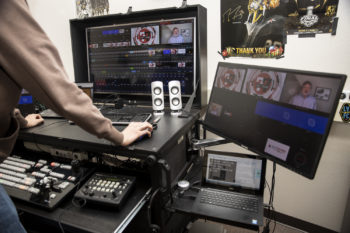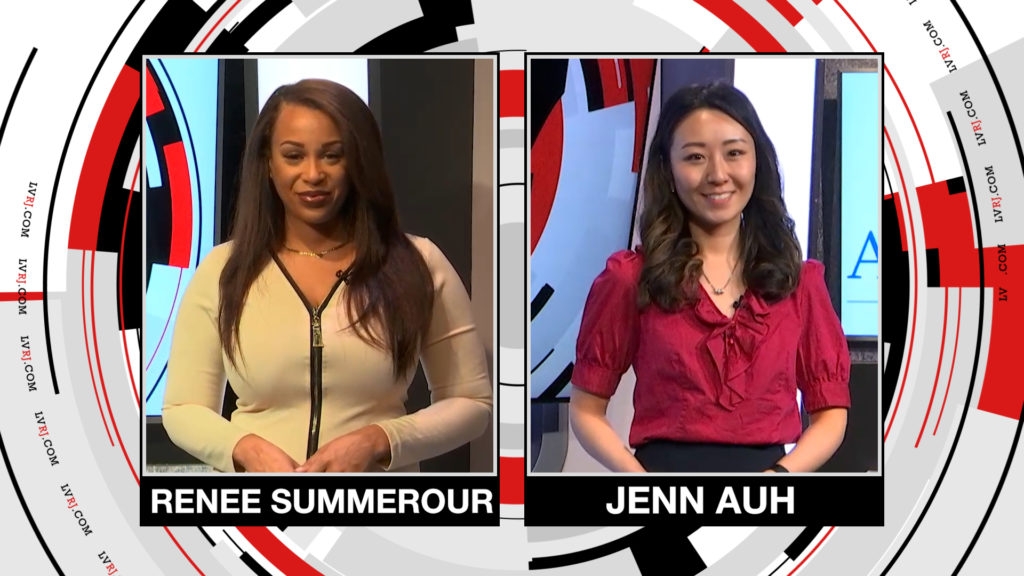How the Las Vegas Review-Journal’s streaming newscast grew audience and revenue
Glenn Cook and Jim Prather, Las Vegas Review-Journal,This is a series on Better News to a) showcase innovative/experimental ideas that emerge from the Knight-Lenfest Newsroom Initiative and b) share replicable tactics that benefit the news industry as a whole. This “win” comes from Glenn Cook, executive editor and senior VP/News, and Jim Prather, executive director of digital programming, both of the Las Vegas Review-Journal. The Review-Journal participated in the 2019-20 Poynter Local News Innovation Table Stakes cohort.
Question: What communities do you serve and what can you tell us about the history of your organization?
Answer: The Las Vegas Review-Journal primarily serves the Las Vegas metropolitan area, which includes the cities of Las Vegas, Henderson and North Las Vegas, and has about 2.25 million residents. The Review-Journal also considers the city’s more than 40 million annual visitors, and all past and potential future visitors, part of its core audience. The Review-Journal provides news and information about tourism, the Las Vegas Strip and the region’s resort, dining, shopping, convention and entertainment scenes.
Las Vegas is a highly searched term on the web, and we work to take advantage of that. In a typical month, reviewjournal.com will have around 4 million unique visitors, and anywhere between two-thirds to three-quarters of those visitors are from outside Nevada.
The Review-Journal and its predecessor newspapers have covered Southern Nevada for more than 110 years. The company was born as the Clark County Review in 1909. Today, the company is locally owned by the Adelson family, who have bolstered the newsroom’s staffing and digital capabilities since purchasing the Review-Journal in 2015.
Q: What problem were you trying to solve, and why was solving the problem strategically important for your organization?
A: Digital content consumers, locally and globally, increasingly favor shorter video clips. This presents significant challenges for the news industry. How do you deliver video news in a way that addresses this trend while creating new revenue opportunities?
TV news is not doing a good job addressing this change in audience habits, sticking with long, slow-paced newscasts. The Review-Journal is accustomed to competing with TV stations in the digital space, but TV stations aren’t making it easy for their website or mobile app visitors to find video.
We saw the shortcomings of local TV news as a video opportunity. We wanted to deliver a video newscast that addressed audience trends, got us ahead of our TV competitors, and used the productivity and expertise of our talented staff.
We wanted to create a new product that would be habit-forming for our audience and attract new advertising dollars. We knew we needed a faster-paced newscast that was convenient for consumers.
Solving this problem was strategically important because digital revenue growth — and video revenue growth — is crucial for our company, and existing and potential advertising clients are looking for unique solutions, just like the audiences we serve.
And, if we executed properly, we knew the initiative would grow our audience and give our existing audience a reason to stay longer on our site. “7@7” was born. Watch the intro video here.
Q: How is this approach related to Table Stakes (e.g. one of the 7 Table Stakes and/or an outgrowth of the Knight-Lenfest initiative, etc.)?
A: Our project hits several Table Stakes.
Table Stake No. 1: Serving a targeted audience with targeted content. We are targeting adults 25-54 with our fast-paced newscast. Initially, our primary targets were adults 44 and younger, those with busier lifestyles and who would be more inclined to favor news on the go, because younger audiences look for video. However, in Q2 we widened that target to include older members of our digital audience who already are RJ loyalists and who might have sampled “7@7” but didn’t make it a habit. Our YouTube data shows our largest audience segment is men 25-45. That’s a great demographic for our sales team.
We put a seven-minute newscast at the top of our home page and automatically attach it to stories that don’t have video content. For “7@7,” we split our content into targeted categories: Top stories, business, weather, sports, sports betting, entertainment, lifestyle, health and breaking news. We picked these verticals based on news research we commissioned on the Las Vegas market.
Table Stake No. 2. Publish on platforms used by your target audience. We are streaming our “7@7” newscast across YouTube, Twitter and our video app, which can be found on Roku, Amazon Fire TV and Apple OTT channels. In addition, we stream our content on our website and the RJ News App. The Las Vegas market is keenly interested in breaking news. It is one of our top content categories. And we can stream that content across all our platforms.
Table Stake No. 3. Produce and publish continuously to meet audience needs. We deliver the streams across all platforms at 7 a.m. and 7 p.m. each weekday. News research indicated these slots were the right time to deliver this content. We now have a weekday video operation that can deliver major local breaking news from 5 a.m.-9 p.m. weekdays. Two shifts in the studio/control room work with our photography and news reporters to stream breaking news events.
Table Stake No. 5. Diversify and grow the ways you earn revenue from the audience you build. We are building revenue through segment sponsorships, rather than commercials. The show’s presenting sponsor has a three-second pre-roll ad that leads off each newscast. All other sponsorships are verbal mentions by the Review-Journal anchor, with graphic logos displayed during the segment. It is a branding opportunity for sponsors, rather than a TV commercial.
We set a goal of 1 million “7@7” views for Q1, 2 million for Q2 and 2.5 million for Q3 and Q4. We exceeded our goal for Q1 and are on track to crush our Q2 goal, currently averaging about 250,000 total views per week across all platforms. As a result, we are on track to triple our video revenue in 2021, and we have a path to making the dedicated video team not only self-sustaining, but profitable.

7@7 anchor Renee Summerour during a recording session at the Las Vegas Review-Journal video studio (Erik Verduzco/Las Vegas Review-Journal)
Q: How did you go about solving the problem?
A: Our leadership team (Publisher/News/Sales/Digital) built the strategic initiative based on news research and discussion about what type of video program would best serve our clients and our audience.
Jim Prather, the Review-Journal’s executive director for programming, was tasked to research new video solutions that were being created for publishing, local news, cable and digital-only outlets. As part of that research, he watched local TV newscasts with a stopwatch in hand. He found that after removing commercial breaks, anchor chit-chat and national and international news stories, the first news block of local TV newscasts had, at most, seven minutes of local news.
In the end, our project went in a direction no one else was going: a seven-minute, non-stop local newscast. Creating two seven-minute weekday newscasts required us to reorganize our video/photo team and create new schedules and duties.
We conducted research in 2019, but COVID-19 delayed project planning. In the summer of 2020, the leadership team evaluated multiple concepts and built ROI models for each potential project. Here’s a timeline:
August-September 2020: Publisher Keith Moyer gave the go-ahead for “7@7.” Crucial to the ROI was redeploying existing staff and resources from broad-based video content creation to a more targeted news product that was more sales friendly. We hired two part-time employees (associate producer and video editor). Jim and our IT team identified the technology that would be required to deliver a streaming product and live breaking news. The sales and news departments worked together on sponsorship opportunities, while also focusing on music, graphics and format.
October-November 2020: We signed technology contracts, including OTT App development, new streaming technology using existing studio/control room platforms. We met with news, sales and operations to outline the project and timeline. We began building a test show that went through extensive internal critiques. After a month of development, we had a test episode to share with clients. The sales team began conversations targeting broadcast budgets of new and existing clients.
December 2020: We identified AM and PM teams for a January launch and created new schedules that went into effect once the NFL season concluded. Training on new technology began. Before schedules changed, we began a seven-week process of building shows. Initially, we produced and edited two shows a week per shift for several weeks, eventually transitioning to producing shows daily on each shift 11 days in advance of our launch on Jan. 18, 2021.
January 2021: We moved two existing show producers from news and sports assignments to focus full-time on “7@7” in January 2021. We launched “7@7” on Jan. 18, 2021, amid COVID-19 restrictions. We needed most of our staff to work from home with limited staff in our studio/control room.
As of June 2021, with more than 200 episodes completed, the bulk of our team still works from home.
Q: What worked?
A:
Technology: We implemented new technology from a company called Bitcentral that allowed us to stream our content from our control room switcher to our RJ OTT channels, website and news app. In addition, we pushed out our streams from our NewTek video switcher onto Twitter and YouTube. We also use a smartphone LiveU app that connects reporters directly to our control room video switcher. We had been streaming live breaking news and live sports programming for 18 months but with the new app, reporters can give us updates from home or from the scene of breaking news.

Nathan Asselin works the TriCaster at the Las Vegas Review-Journal video studio. (Erik Verduzco/Las Vegas Review-Journal)
We had a foundation for delivering live content on targeted timelines including live NFL Draft programs and 17 live hour-long pre-game shows for the first season of Las Vegas Raiders. We set aside training time for staff on our new technology. The video team had more technology training. The digital content team had to set up new systems for live and streaming program deployment.
Our reporters in the field and at home could dial into our control room and give us the latest information on their stories. We use this same technology and additional audio gear to cover live breaking news events using smartphones. That was on top of our existing LiveU units that our videographers used to transmit live signals back to the newsroom and studio.
Create once and distribute across multiple platforms: We have seen dramatic growth in video engagement on YouTube, Twitter and our website/app. We also cut up our shows via content sections and create up to 80 standalone videos per week that accompany stories. These segments are also loaded into our STN video player, which provides pre-roll revenue along with national syndication revenue we share with STN.
The largest audience comes from reviewjournal.com (we attach the seven-minute show to every story without a video). Our standalone videos are the second biggest driver of video usage. Streaming the shows on Twitter and YouTube delivers a large number of video views. Our RJ YouTube channel has added 5,000 subscribers since we launched in January.
Breaking news: We are growing our audience because we can deliver live, breaking local content to our website and other platforms. We have a studio anchor ready to front and close the breaking news with context. Our breaking news coverage offers another sponsorship opportunity that has generated revenue. 7@7 program generates substantial video views on our website as well as on YouTube and Twitter.
Staff adaptation: Our staff is amazing. They adapted quickly to changing schedules (some staff now start at 3:30 a.m.), new technology and aggressive breaking news execution. Our vendors provided good training, which helped. We also spent a month practicing. We critiqued our content each day, and it improved dramatically. We continue the self-critiques, and, as a result, the shows, graphics, presentation and production values continue to improve. Our reporters and photographers stepped up and out of their comfort zones.
Each weekday, we ask reporters to join us on camera to discuss targeted stories we have selected for the show. They continue to grow as video talent, and it improves our storytelling. Our still photographers now use their smartphones to shoot video and stream live breaking coverage.
Sales team: They embraced the challenge and are exceeding revenue expectations. The sales group brought on new and current clients and even some who had moved away from print as sponsors. Many of the clients were new to the digital space, and it gave us the opportunity to sell an exclusive digital offering in the market from a trusted source. We targeted clients’ broadcast budgets to grow new revenue streams.

Las Vegas Review-Journal 7@7 anchors Jenn Auh and Renee Summerour and studio host Cassie Soto (Benjamin Hager/Las Vegas Review-Journal)
Diversity on the anchor desk: We have the most diverse anchor team in the Las Vegas market. Renee Summerour, Jenn Auh, Cassie Soto, Le’Andre Fox and Heidi Fang all contribute to our video efforts. All of our on-air talent was existing staff. Jenn was recruited when one of our anchor/producers resigned because of family commitments.
Improved planning: Janet Murphy, digital producer, was moved into a planning manager position. She is the cornerstone of communication between our news, digital and video teams. She looks at content creation with a daily, weekly and monthly point of view. We have shorter digital content meetings with fewer staff involved. We have also created daily planning meetings for the AM and PM teams. We look ahead to the next show and the next-day plan.
Q: What didn’t work?
A: Posting “7@7” to Facebook. The Facebook algorithm apparently did not like our sponsorship pre-roll and sponsorship segments for the seven-minute show. The algorithm punished our other content as a result. After several weeks, we abandoned efforts to stream this newscast on Facebook. However, growth in other platforms more than made up for the projected streams from FB.
OTT subscriber growth is a work in progress. We are getting viewers, but we need to market and train the audience so they can find our content on OTT channels.
Q: What happened that you didn’t expect?
A: After several months of training and real-time experience, we have improved our communication between the digital team, publishing team and video/photo teams. Our breaking news coverage has exceeded expectations. Now, we don’t just post the story. We are asking if there is a live video stream to attach, new video, graphics, audio content, etc.
We changed our digital meetings to focus on the big stories and content that would be needed for “7@7.” We limited the number of participants and that has freed up staff to tackle other work while accelerating the pace of decision-making and story selection.
We didn’t expect our competitors to react so swiftly. We have a number of news/digital employees who previously worked at local television stations. Some of them got calls from former TV colleagues the week “7@7” launched and were asked about everything from how we did it amid a pandemic to how we got sponsorships in a depressed local economy.
The ABC (KTNV) and Fox(KVVU) affiliates launched shorter news programs in response, and not long after that, Telemundo Las Vegas debuted a two- to three-minute streaming newscast that’s available through the channel’s app. We expect more copying to follow.
Q: What would you do differently now? What did you learn?
A: We stretched our resources to launch “7@7” on an aggressive timeline, taking about four months to take it from idea to debut. But we didn’t do a good enough job early in the process of promoting our presence on OTT channels.
In May, we created video promotions/tutorials to show viewers how to watch “7@7” and other video programming on Apple TV, Roku and Fire TV and how to subscribe to our YouTube channel. We’re hopeful that these videos, once attached to stories and shared on social media, will help grow our audience even more quickly, and that current fans of the newscast will enjoy watching the news on their big-screen TVs as well as on their mobile devices.
Q: What advice would you give to others who try to do this?
A:
Do your research: Newspapers are the leaders in content creation. We can also lead in video and live breaking news. Technology can streamline and improve your workflow.
Having the right people in the right jobs is crucial: Look to promote from within your organization. Our morning producer is a former copy editor for the print universal desk. He is an excellent writer, has outstanding news judgment and has been trained on how to produce a newscast.
Training is HUGE: Train your team on the mission and expectations. Train new employees. Train for technology.
Plan for a month or more of practice shows: You need to create a production cycle and get the video, digital and print-focused teams to work together. This practice will give reporters a sense of on-camera expectations, from camera quality to appropriate dress to rehearsed delivery. It also helps you identify the best backgrounds for your talent.

Las Vegas Review-Journal 7@7 anchors Renee Summerour and Jenn Auh are seen with some of the onscreen graphics. Graphics and animations reinforce the new brand. (Las Vegas Review-Journal)
Video graphics and a music package: You are building a new brand, so you need to reinforce it with graphics and animations. They make the show move much faster. Create a video and music vision for the show. We used vendors for ours, with great results. The program is visually slick.
Planning and analytics: We took one of our most experienced digital producers and gave her responsibility for coordinating/tracking content throughout the day and making sure we were thinking about “7@7” with each of the key stories. Planning ahead for the next day, the next week and big events. Our planning producer is in the middle of the process with all stakeholders. That has really helped us streamline and distribute the content. And multiple departments are involved in measuring and tracking KPIs, with a weekly meeting scheduled to review them. Changes in numbers are discussed. What’s changed? Why?
Q: Is there anything else you’d like to add?
A: “7@7” has created buzz among our audience. Staff across all departments frequently get compliments from readers/subscribers/clients about how much they enjoy the pace and brevity of the show. It has been validating for us.
The Review-Journal previously had invested in a video studio for programming, but having a studio that compares with a traditional TV anchor desk isn’t necessary to pull off this kind of programming. A broadcast space within your newsroom, with your staff in the background, can work just as well.
Also, don’t be afraid to set bold goals. If your work product is strong, and you market it effectively, audience growth will follow.
We plan to grow video content that can attract and serve the broadcast audience. You don’t need a TV transmitter to deliver video to a mass audience. You need a dynamic website, mobile strategy and social channels. The audience is demanding that content be delivered as it breaks and at a time when it is convenient for the news consumer.
We will continue to focus on highly produced, faster-paced content that our audience wants to watch. We are also looking to use our legacy photo/video archive content to generate new programming on the history of Las Vegas.